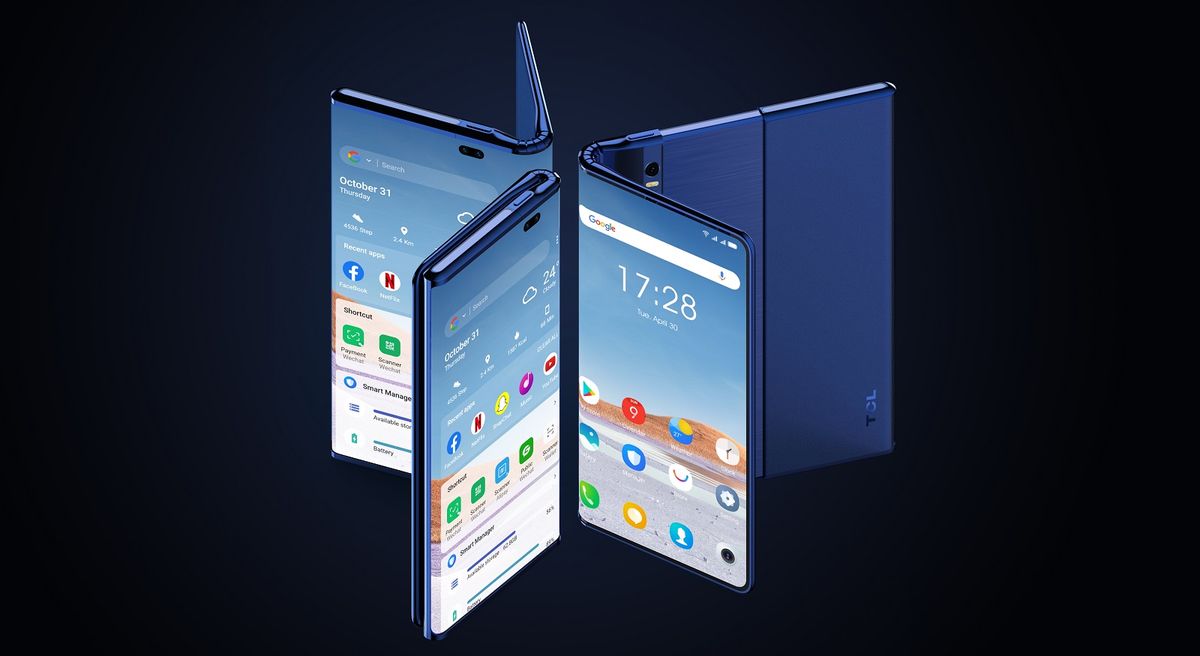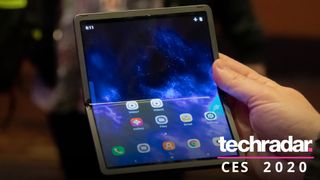TCL's Fold 'n Roll is both a rollable and a foldable phone – so when do we get one?
The TCL Rollable sequel folds AND rolls, so when can we buy it?

The end of TCL’s April TCL 20 announcement event had a special surprise for viewers...and the phones industry as a whole, really: the company revealed the TCL Fold N’ Roll, the first device that is both a foldable and a rollable.
The Fold n’ Roll is more than just a concept combining the phones industry’s top buzzwords of 2020 and 2021 – it could be a harbinger of a new era in phones, when flexible display handsets become readily available (and cheap) enough to hit the mainstream in the next two years.
That’s according to two TCL executives, who sat down with TechRadar to chat about what the normalization of these devices means to consumers.
While other phonemakers have been first to market with pricey foldable phones, the executives suggested that TCL’s mobile product strategy – releasing mid-range and budget-priced devices – is being applied to foldable production.
“We don’t feel pressured to come out very early with something like this,” Stefan Streit, TCL General Manager of Global Marketing, told TechRadar. “Our job is to bring this into a mass market.”

It’s been no secret that TCL is looking into lower-tier foldables after the company revealed a cheaper clamshell foldable-looking concept device at CES 2020, but then again, it’s given peeks at a lot of display types that will probably never reach the market.
TCL was unclear how serious it was about developing cheaper flexible display devices... until now.
Get daily insight, inspiration and deals in your inbox
Sign up for breaking news, reviews, opinion, top tech deals, and more.
Selling affordable flexible display devices, starting with a foldable device that TCL confirmed to CNET will be coming in 2021, has implications for the phones market as a whole. If TCL thinks they can make more affordable folding, rolling, and other kinds of flex-display phones, other companies will, too. And all that R&D will result in wild, new form factors.
“To generalize, you will see a much bigger variety in a couple years of different product form factors – and it’ll be very fun for you guys where you can talk about different use cases and such,” Streit said. “We’re probably just beginning to understand what is possible and we’re trying to explore this. It’s going to be a lot of fun.”
There’s no way to tell if the Fold N’ Roll is one of the few TCL concepts that will reach the market as a cheap flexible display device. But it’s proof that TCL is continuing to tinker with different display ideas and, given what we’ve heard, the company is bringing some to market just as flexible display phones get big – starting, in 2021, with a foldable device.
It wouldn't be CES without TCL showing off some future tech concepts! This is the AMOLED Rollable Display: It can extend from 6.7" to 7.8" with a tap of the finger. #CES2021 @TCL_USA @TCLMobileGlobal pic.twitter.com/Gtxihs7eDDJanuary 11, 2021
Phase one: foldable in 2021, rollable in 2022
While the TCL Rollable was first teased at CES 2021 and first reports indicated it would launch later this year, the company had carefully stated that a flexible display device would come in 2021 – and it looks like they were referring to a foldable.
Instead, the TCL Rollable could have a 2022 release date, Streit said: “To be clear, I wouldn’t expect it as a commercial device in the first half of next year, not yet. But maybe this could be something in the second half of next year,” he said.
Even a TCL Rollable in 2022 would still catch the wave of more flexible display devices that TCL’s executives predict will crest in a year and a half to two years time. That’s when TCL expects it will figure out the thornier issues of hinges and screen-unfurling systems in foldables and rollables, respectively: they’ve got the ‘display’ aspect figured out, it’s the ‘flexible’ aspect that needs time to develop.
“[We feel] very comfortable for the panel itself that we can do that part, but the other challenge is to make the mechanics to do this, and also [develop] the user experience,” Streit said.
Some of those growing pains have largely been figured out for foldables, but for the Fold 'n Roll, and even basic rollables, there’s another design challenge to solve for the still-novel mechanics involved in unrolling and retracting a display: durability.
“Dust, water, all kinds of circumstances, drops, humidity – it’s all part of the lab tests we need to do before we can bring something commercial to the market,” Streit said. But he expects these issues to be worked out in time.
“The internal progress we’re doing and seeing these things come together gives us the confidence that, looking forwards one and a half to two years, you could see more of these technologies and kinds of products feasible for commercial thinking.”
But as you would expect, in two years, prices will probably drop for components crucial to flexible screens, especially as more rollable phones are released, which use similar parts.
“Next year, foldables and rollables will compete with each other, and because of that competition, we can push down our component prices,” said Steve Kim, OLED Expert at TCL-CSOT, the department that develops displays for the company’s various products. “So maybe next year we can get some relatively cheaper prices on our flexible devices.”
That leads to cheaper foldables and rollables. But TCL is no stranger to flexible display concept phones, and has shown off plenty in the short two-year period since it started releasing its own TCL-branded handsets. What’s holding us back from moving beyond those?
In case you missed it or want to watch again: Here's the teaser video of the TCL Fold 'n Roll, our latest display concept that acts as a 3-in-1 device: smartphone, mini tablet, and full-size tablet. @TCLMobileGlobal pic.twitter.com/LQW5Pe9pAHApril 14, 2021
Fold N’ Roll: the best we can do with today’s tech, but not tomorrow’s
The Fold 'n Roll is novel, but it combines two relatively proven flexible display versions – and it may be the most we can do with today’s phone technology due to the limits of materials science.
As Streit and Kim explained, smartphone designers are largely held back by battery technology. Nearly every other part of a handset can bend but the battery, which is why you see so many flexible display ideas stuck at the concept stage – including the wrap-around-wrist devices that have shown up over the years.
“I’m looking for a kind of flexible battery, but also, how much can we reduce the battery’s thickness,” Kim said, noting that the display panels are already thin enough – 400 micrometers, even – to use in a rollable form factor. Thinner batteries, of course, could allow some of the more complex foldable designs, like the Z-shaped trifold concepts TCL and other phonemakers have teased.
With today’s tech, those are essentially three smartphones thick – which is too dense for the average user to fit in their pocket. Hence why the Fold 'n Roll is a tantalizing stopgap: it unfolds to a 10-inch tablet-sized display, but folds back up to a typical tall, narrow smartphone size that consumers are familiar with.
It makes sense for TCL and other phone manufacturers to stay close to a form factor consumers are familiar with and can get the functionality they’re used to while experimenting with new and interesting ways to use their devices. But there’s still an inextricable draw to move beyond today’s norm, and Streit thinks it’ll happen when enough foldable and rollable (and Fold N’ Roll-able) devices hit the market in the next couple years.
And after that – what screen concepts come after flexible displays?
“Nowadays we are seeing the three-dimensional [device], but in the future we are looking for some hologram technology,” Kim said. “That’s not possible today, but we are looking for some kind of roadmap to see a three-dimensional imaging system, so for that matter, the flexible display is a very good device to achieve such a goal.”
- Stay on top of tech news with the TechRadar newsletter
David is now a mobile reporter at Cnet. Formerly Mobile Editor, US for TechRadar, he covered phones, tablets, and wearables. He still thinks the iPhone 4 is the best-looking smartphone ever made. He's most interested in technology, gaming and culture – and where they overlap and change our lives. His current beat explores how our on-the-go existence is affected by new gadgets, carrier coverage expansions, and corporate strategy shifts.
